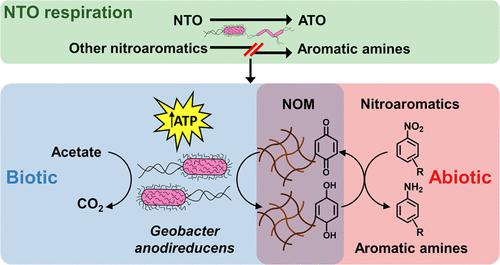当前位置:
X-MOL 学术
›
Environ. Sci. Technol.
›
论文详情
Our official English website, www.x-mol.net, welcomes your
feedback! (Note: you will need to create a separate account there.)
Quinone Moieties Link the Microbial Respiration of Natural Organic Matter to the Chemical Reduction of Diverse Nitroaromatic Compounds
Environmental Science & Technology ( IF 10.8 ) Pub Date : 2022-06-15 , DOI: 10.1021/acs.est.2c01329 Osmar Menezes 1 , Kumru Kocaman 2 , Stanley Wong 1 , Erika E Rios-Valenciana 1 , Eliot J Baker 1 , Janet K Hatt 2 , Jianshu Zhao 3 , Camila L Madeira 1 , Mark J Krzmarzick 4 , Jim C Spain 2, 5 , Reyes Sierra-Alvarez 1 , Konstantinos T Konstantinidis 2 , Jim A Field 1
Environmental Science & Technology ( IF 10.8 ) Pub Date : 2022-06-15 , DOI: 10.1021/acs.est.2c01329 Osmar Menezes 1 , Kumru Kocaman 2 , Stanley Wong 1 , Erika E Rios-Valenciana 1 , Eliot J Baker 1 , Janet K Hatt 2 , Jianshu Zhao 3 , Camila L Madeira 1 , Mark J Krzmarzick 4 , Jim C Spain 2, 5 , Reyes Sierra-Alvarez 1 , Konstantinos T Konstantinidis 2 , Jim A Field 1
Affiliation

|
Insensitive munitions compounds (IMCs) are emerging nitroaromatic contaminants developed by the military as safer-to-handle alternatives to conventional explosives. Biotransformation of nitroaromatics via microbial respiration has only been reported for a limited number of substrates. Important soil microorganisms can respire natural organic matter (NOM) by reducing its quinone moieties to hydroquinones. Thus, we investigated the NOM respiration combined with the abiotic reduction of nitroaromatics by the hydroquinones formed. First, we established nitroaromatic concentration ranges that were nontoxic to the quinone respiration. Then, an enrichment culture dominated by Geobacter anodireducens could indirectly reduce a broad array of nitroaromatics by first respiring NOM components or the NOM surrogate anthraquinone-2,6-disulfonate (AQDS). Without quinones, no nitroaromatic tested was reduced except for the IMC 3-nitro-1,2,4-triazol-5-one (NTO). Thus, the quinone respiration expanded the spectrum of nitroaromatics susceptible to transformation. The system functioned with very low quinone concentrations because NOM was recycled by the nitroaromatic reduction. A metatranscriptomic analysis demonstrated that the microorganisms obtained energy from quinone or NTO reduction since respiratory genes were upregulated when AQDS or NTO was the electron acceptor. The results indicated microbial NOM respiration sustained by the nitroaromatic-dependent cycling of quinones. This process can be applied as a nitroaromatic remediation strategy, provided that a quinone pool is available for microorganisms.
中文翻译:

醌部分将天然有机物的微生物呼吸与多种硝基芳族化合物的化学还原联系起来
不敏感弹药化合物 (IMC) 是一种新兴的硝基芳香族污染物,由军方开发,作为传统炸药的更安全的替代品。仅报道了有限数量的底物通过微生物呼吸进行硝基芳烃的生物转化。重要的土壤微生物可以通过将其醌部分还原为氢醌来呼吸天然有机物 (NOM)。因此,我们研究了 NOM 呼吸与形成的氢醌对硝基芳烃的非生物还原相结合。首先,我们建立了对醌呼吸无毒的硝基芳香族浓度范围。然后,以Geobacter anodireducens为主的富集培养物可以通过首先呼吸 NOM 组分或 NOM 替代物蒽醌-2,6-二磺酸盐 (AQDS) 间接减少广泛的硝基芳烃。在没有醌的情况下,除 IMC 3-nitro-1,2,4-triazol-5-one (NTO) 外,没有测试的硝基芳烃被还原。因此,醌呼吸扩大了易于转化的硝基芳烃的光谱。该系统在非常低的醌浓度下运行,因为 NOM 通过硝基芳族还原而循环。宏转录组学分析表明,当 AQDS 或 NTO 为电子受体时,呼吸基因上调,微生物从醌或 NTO 还原中获得能量。结果表明微生物 NOM 呼吸由醌的硝基芳香依赖性循环维持。该过程可用作硝基芳烃修复策略,
更新日期:2022-06-15
中文翻译:

醌部分将天然有机物的微生物呼吸与多种硝基芳族化合物的化学还原联系起来
不敏感弹药化合物 (IMC) 是一种新兴的硝基芳香族污染物,由军方开发,作为传统炸药的更安全的替代品。仅报道了有限数量的底物通过微生物呼吸进行硝基芳烃的生物转化。重要的土壤微生物可以通过将其醌部分还原为氢醌来呼吸天然有机物 (NOM)。因此,我们研究了 NOM 呼吸与形成的氢醌对硝基芳烃的非生物还原相结合。首先,我们建立了对醌呼吸无毒的硝基芳香族浓度范围。然后,以Geobacter anodireducens为主的富集培养物可以通过首先呼吸 NOM 组分或 NOM 替代物蒽醌-2,6-二磺酸盐 (AQDS) 间接减少广泛的硝基芳烃。在没有醌的情况下,除 IMC 3-nitro-1,2,4-triazol-5-one (NTO) 外,没有测试的硝基芳烃被还原。因此,醌呼吸扩大了易于转化的硝基芳烃的光谱。该系统在非常低的醌浓度下运行,因为 NOM 通过硝基芳族还原而循环。宏转录组学分析表明,当 AQDS 或 NTO 为电子受体时,呼吸基因上调,微生物从醌或 NTO 还原中获得能量。结果表明微生物 NOM 呼吸由醌的硝基芳香依赖性循环维持。该过程可用作硝基芳烃修复策略,











































 京公网安备 11010802027423号
京公网安备 11010802027423号